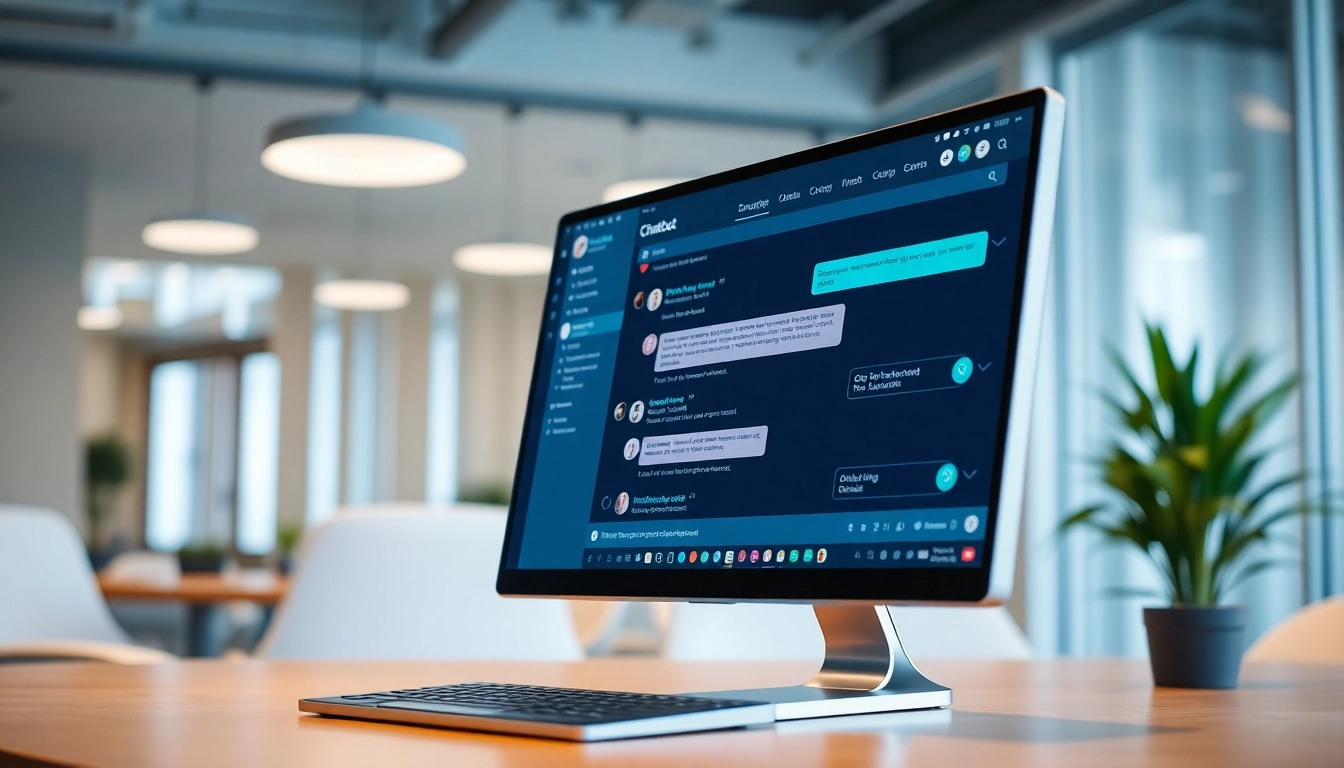Understanding the Importance of a Chatbot for Your Website
In today’s digital landscape, having an efficient means of communication on your website is paramount. A chatbot for website integration has emerged as a crucial tool to bridge the interaction gap between businesses and customers. Whether it’s facilitating immediate responses or handling multiple queries simultaneously, chatbots are transforming how organizations communicate with their audience. In this article, we’ll dive deep into the significance of chatbots, exploring their functionalities, benefits, and the various types available to suit diverse needs.
What is a Chatbot and How Does it Function?
A chatbot is a software application designed to automate conversations with users, using artificial intelligence (AI) and natural language processing (NLP) technologies. They can mimic human interactions through text-based interfaces and voice commands. Chatbots operate in a conversational manner, providing users with information, answering queries, and even performing tasks on behalf of users. They are designed to provide a seamless experience, helping to enhance customer satisfaction and engagement.
Essentially, chatbots can operate on various platforms—social media, websites, or messaging applications. Their primary functionalities include:
- Automatic Response Generation: They can recognize user inputs and generate appropriate responses based on pre-set rules or machine learning models.
- Data Collection: Chatbots can gather data from user interactions which can help improve services or solve issues faster.
- Task Automation: Performing routine tasks like booking appointments, processing orders, or providing immediate customer support.
The Benefits of Implementing a Chatbot for Your Website
Adding a chatbot feature to your website can revolutionize your customer engagement strategy. Among the numerous benefits of implementing a chatbot, some of the most significant include:
- 24/7 Availability: Unlike human agents, chatbots can operate round the clock, ensuring that customers receive assistance whenever they need it.
- Reduced Operational Costs: Chatbots can handle numerous inquiries at once, reducing the need for extensive customer service teams and lowering operational costs.
- Improved Response Time: With instant replies, chatbots enhance the user experience by resolving queries more swiftly than human counterparts.
- Scalability: As your business grows, chatbots can easily manage increased interaction volumes without requiring additional investments in human resources.
- Consistent Customer Support: Chatbots provide uniform responses, ensuring that users receive accurate information every time they interact.
Who Can Benefit from a Chatbot on Their Site?
While virtually any business can enhance its customer experience with a chatbot, specific industries can particularly benefit from this technology:
- E-commerce: Chatbots can assist buyers in navigating products, processing transactions, and addressing their concerns instantly.
- Healthcare: They can help schedule appointments, provide medical information, and remind patients of upcoming visits.
- Education: Chatbots can answer students’ queries regarding course details, syllabuses, and even help with enrollment processes.
- Travel and Hospitality: These chatbots can assist in booking flights, offering travel advice, and providing support during emergencies.
Types of Chatbots and Their Use Cases
Understanding the different types of chatbots and their unique use cases can help businesses choose the most appropriate option for their specific needs. The two primary types of chatbots include:
Rule-Based Chatbots vs. AI-Powered Chatbots
Rule-based chatbots operate based on a predefined set of rules, generally employing a script that directs conversations. They excel in scenarios with straightforward questions and answers but can struggle with complex inquiries due to their limited capabilities.
On the other hand, AI-powered chatbots utilize machine learning and natural language processing to understand and respond to user queries. They not only comprehend the context behind questions but also learn from interactions, progressively improving their performance over time.
Use Cases:
- Rule-Based Chatbots: Ideal for FAQs, appointment scheduling, and straightforward customer queries.
- AI-Powered Chatbots: Suitable for complex customer support, personalized recommendations, and handling dynamic conversations.
Industry-Specific Chatbot Implementations
Businesses across various sectors have adopted chatbots to leverage their potential fully. Some industry-specific implementations include:
- Banking: Banks use chatbots for transaction inquiries, fraud alerts, and account balance checks.
- Real Estate: Chatbots can help agents connect with potential buyers instantly, answering their questions about listings and schedule viewing appointments.
- Telecommunications: They assist customers with network issues, billing inquiries, and plan recommendations.
Choosing the Right Chatbot for Your Website
Selecting the ideal chatbot requires assessing your unique business needs, customer expectations, and the complexity of interactions you wish to handle. When choosing a chatbot, consider the following:
- Number of Expected Interactions: Gauge how frequently visitors engage with your website.
- Complexity of Inquiries: Evaluate whether most questions are straightforward or require intricate, context-driven responses.
- Budgetary Constraints: Establish how much you are willing to invest in chatbot technology.
- Integration Capabilities: Ensure the chosen chatbot can seamlessly integrate with your existing systems and platforms.
Designing an Effective Chatbot Interface
The interface of your chatbot is crucial in providing a smooth user experience. A well-designed interface not only captures user attention but also fosters engagement.
Key Features to Include in Your Chatbot
When designing your chatbot, incorporating essential features enhances its effectiveness. Key features to consider include:
- Welcome Message: A friendly greeting can set the tone for the interaction and encourage users to engage.
- Quick Reply Options: Providing buttons for common queries facilitates an effortless navigation experience.
- Human Handover: In scenarios where the chatbot cannot address an issue effectively, directing users to a human representative is imperative.
- Customization: Allow users to customize their chat experience based on preferences, boosting engagement.
User Experience Best Practices for Chatbot Design
User experience (UX) is critical in chatbot design. Here are essential best practices:
- Simplicity: Keep conversations straightforward and minimize user effort.
- Personality: Establish a consistent brand voice to give your chatbot personality and create deeper connections with users.
- Visual Elements: Use visuals like emojis, quick reply buttons, and rich media to enhance interactions and make them more engaging.
Testing and Iterating Your Chatbot Design
Continuous improvement of your chatbot is vital. Regular testing and iterations ensure optimal performance. Tips for effective testing include:
- User Testing: Gather real user feedback regarding usability and effectiveness to make necessary adjustments.
- Analytics: Track usage data and common interaction patterns to identify potential areas of improvement.
- A/B Testing: Experiment with different designs or response styles to see which resonates best with users.
Integrating Your Chatbot with Existing Tools
A successful chatbot implementation hinges on its ability to integrate with your existing business tools seamlessly. Effective integration can facilitate smoother operations and improved workflows.
Connecting Your Chatbot to CRM and Helpdesk Systems
Linking your chatbot to your Customer Relationship Management (CRM) and helpdesk systems can create a cohesive customer support environment:
- Customer Profiles: A connected chatbot can access customer history, leading to personalized interactions.
- Task Automation: Integrating with helpdesk systems can automate ticket creation for unresolved inquiries.
- Improved Data Utilization: Chatbots can pull relevant customer data from CRM to enhance the service experience.
Using Analytics to Optimize Chatbot Performance
Utilizing analytics is crucial for optimizing your chatbot’s effectiveness. Regular analysis can help you understand user interactions and identify improvement opportunities. Important metrics to watch include:
- Engagement Rate: Measure the percentage of visitors interacting with your chatbot.
- Response Time: Analyze how quickly your chatbot responds to queries.
- User Retention: Evaluate how many users return for assistance via the chatbot.
Maintaining and Updating Your Chatbot over Time
To ensure a chatbot remains effective, it requires ongoing maintenance and updates. Consider the following strategies for successful upkeep:
- Regular Content Updates: As products, services, and policies change, update your chatbot’s knowledge base accordingly.
- Monitor Performance: Use analytics insights to pinpoint areas needing enhancement and revisit bot interactions frequently.
- Continuous Learning: Implement machine learning algorithms to enable the bot to learn from past interactions and improve continually.
Measuring the Success of Your Website Chatbot
To determine the effectiveness and ROI of your chatbot, it’s essential to measure its success accurately. This can involve various approaches and metrics.
Key Performance Indicators for Chatbot Effectiveness
To assess the performance of your chatbot, focus on several critical performance indicators:
- Response Accuracy: Measure the percentage of inquiries successfully resolved by the chatbot without human intervention.
- Customer Satisfaction Rate: Conduct surveys after chatbot interactions to gauge customer satisfaction and gather insights.
- Conversion Rates: Evaluate how many chatbot interactions led to desired user actions, such as purchases or form submissions.
Gathering User Feedback and Making Improvements
Collecting user feedback is vital for continually refining your chatbot. Effective methods include:
- Surveys and Polls: Directly ask users about their experiences with the chatbot.
- Monitor Interactions: Analyze specific conversations to identify frequent pain points and areas needing improvement.
- A/B Testing: Test different versions of chatbot responses, procedures, or features to assess user preferences and enhance overall satisfaction.
Case Studies: Successful Chatbot Implementations
Real-world case studies can provide valuable insights into the effective deployment of chatbots. For instance:
- Spectrum: The telecommunications giant employed a chatbot to handle billing inquiries, leading to a 30% reduction in call volume.
- Sephora: The beauty retailer’s chatbot assists with product recommendations, enhancing customer shopping experiences and boosting sales.
- HDFC Bank: By integrating a chatbot on their website, they reported significantly increased customer engagement, with inquiries managed at a fraction of previous costs.
These examples underscore how well-implemented chatbots can lead to enhanced user satisfaction, operational efficiency, and ultimately, increased loyalty and sales.



